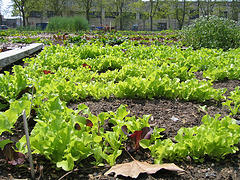
- Image by ambienttraffic via Flickr
In roughly 50 years farming as we know it will no longer exist
IF climate change and population growth progress at their current pace, in roughly 50 years farming as we know it will no longer exist. This means that the majority of people could soon be without enough food or water. But there is a solution that is surprisingly within reach: Move most farming into cities, and grow crops in tall, specially constructed buildings. It’s called vertical farming.
The floods and droughts that have come with climate change are wreaking havoc on traditional farmland. Three recent floods (in 1993, 2007 and 2008) cost the United States billions of dollars in lost crops, with even more devastating losses in topsoil. Changes in rain patterns and temperature could diminish India’s agricultural output by 30 percent by the end of the century.
What’s more, population increases will soon cause our farmers to run out of land. The amount of arable land per person decreased from about an acre in 1970 to roughly half an acre in 2000 and is projected to decline to about a third of an acre by 2050, according to the United Nations. With billions more people on the way, before we know it the traditional soil-based farming model developed over the last 12,000 years will no longer be a sustainable option.
Irrigation now claims some 70 percent of the fresh water that we use. After applying this water to crops, the excess agricultural runoff, contaminated with silt, pesticides, herbicides and fertilizers, is unfit for reuse. The developed world must find new agricultural approaches before the world’s hungriest come knocking on its door for a glass of clean water and a plate of disease-free rice and beans.
Imagine a farm right in the middle of a major city. Food production would take advantage of hydroponic and aeroponic technologies. Both methods are soil-free. Hydroponics allows us to grow plants in a water-and-nutrient solution, while aeroponics grows them in a nutrient-laden mist. These methods use far less water than conventional cultivation techniques, in some cases as much as 90 percent less.
Now apply the vertical farm concept to countries that are water-challenged — the Middle East readily comes to mind — and suddenly things look less hopeless. For this reason the world’s very first vertical farm may be established there, although the idea has garnered considerable interest from architects and governments all over the world.
Vertical farms are now feasible, in large part because of a robust global greenhouse initiative that has enjoyed considerable commercial success over the last 10 years. (Disclosure: I’ve started a business to build vertical farms.) There is a rising consumer demand for locally grown vegetables and fruits, as well as intense urban-farming activity in cities throughout the United States. Vertical farms would not only revolutionize and improve urban life but also revitalize land that was damaged by traditional farming. For every indoor acre farmed, some 10 to 20 outdoor acres of farmland could be allowed to return to their original ecological state (mostly hardwood forest). Abandoned farms do this free of charge, with no human help required.
A vertical farm would behave like a functional ecosystem, in which waste was recycled and the water used in hydroponics and aeroponics was recaptured by dehumidification and used over and over again. The technologies needed to create a vertical farm are currently being used in controlled-environment agriculture facilities but have not been integrated into a seamless source of food production in urban high-rise buildings.
Related articles by Zemanta
- Six Urban Farms, From U.S. Coast to Coast (sustainablog.org)
- Green Inc. Column: Firm Brings Farming to the Masses (nytimes.com)
- BLDGBLOG: London Yields: Urban Agriculture (hermenaut.org)
- Getting Real About the High Price of Cheap Food – TIME (time.com)
- Will Allen: “Industrial Agriculture One of Most Polluting & Dangerous Industries” (treehugger.com)
- Is Urban Farming the Next Pinkberry? (laist.com)
- Projected food, energy demands seen to outpace production (scienceblog.com)









